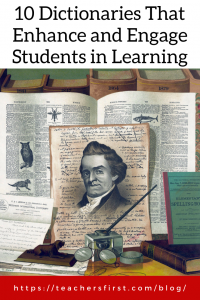Noah Webster is broadly considered to be the father of the American dictionary. In his honor, October 12 commemorates National Dictionary Day, his birthdate. This date marks learning and encourages readers to improve vocabulary.
Most classrooms now rely on digital dictionaries to look up word meanings. Digital dictionaries are easy to use and provide information not available in books. These tools offer options to hear proper pronunciations of words and often provide images making them an excellent opportunity for providing expanded content to all learners. These tools also provide upgraded access to students with visual and audio impairments. In addition, many dictionaries include interactive activities to deepen their understanding of the terms.
Here are some dictionaries to consider sharing with students in your classroom. Consider adding links of your favorites to your classroom website for students to access quickly. These tools are also excellent to include as part of a computer learning center for students to explore and interact with as a vocabulary development exercise.
Dictionary.com (reviewed here) – This site is much more than a resource for finding word definitions. Choose the games section to complete crosswords, take quizzes, and solve word puzzles. Learn by visiting word lists, discovering a new word each day, or stay up to date with trending words.
Illustrated Mathematics Dictionary (reviewed here) – Use this dictionary to find the definitions of math words. Definitions are easy to understand and include images and animations to define the terms.
Learner’s Dictionary (reviewed here) – Merriam Webster offers the Learner’s Dictionary featuring a word of the day, quizzes, and an ask the editor section. In addition, the Core Vocabulary portion includes a set of lists with 3000 core words that are most important for learners to know and understand.
Wordsmyth Illustrated Learner’s Dictionary (reviewed here) – This illustrated dictionary for kids also includes audio pronunciation of English, Spanish, and Chinese words.
Vidtionary (reviewed here) – Learn about words with videos at Vidtionary. The short videos define terms by showing example scenes with words. Browse to find specific words or use the dropdown boxes to find words in collections, by categories, or complete quizzes based upon different topics and skill levels.
Handspeak (reviewed here) – This dictionary provides support for American Sign Language. Look up words for viewing how to use visual and hand expressions to converse with deaf and hard-of-hearing people. This dictionary also includes a reverse lookup; use this to view a video and interpret the word. Also included are a first 100 words list and a Kid’s ASL workbook.
EasyDefine (reviewed here) – EasyDefine is a simplified version of a dictionary for finding definitions of single words. Type in a word or list of words to generate a list of definitions. Then, visit the extras link to use your search terms to create a list of synonyms, a quiz, flashcards, or practice worksheets.
Lingro (reviewed here) – Defining words found on websites is easy with Lingro. Copy the URL of a website into Lingro to make all words clickable to define unknown words. Options include many choices for translating text between several languages.
Visuwords (reviewed here) – As the name implies, Visuwords defines itself as a visual dictionary, visual thesaurus, and interactive lexicon. Search for any word to view an interactive representation color-coded based on the word’s part of speech and usage. Then, click on any portion of the visual to view a definition based upon the word’s placement in the interactive.
OneLook Reverse Dictionary (reviewed here) – Instead of looking for a definition, OneLook lets users search for words based upon a concept. For example, find words based on a term you know, such as museum guide. This search leads to the response of the word “docent.” OneLook is also helpful for finding synonyms and creating word lists.
It is still essential to use and teach with physical dictionaries. They help students understand alphabetical order, use guide words, find multiple meanings, and see phonetic spellings.
Digital dictionaries typically include many of the above options and incorporate media to make content more accessible. In addition, online dictionaries are available to us almost anywhere.
What dictionaries do you use in your classroom? How have you used them to build vocabulary and extend learning? Let us know your ideas as we learn together.


